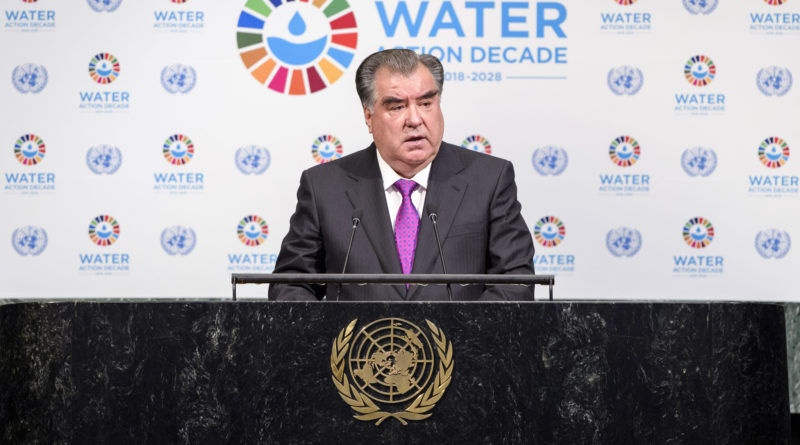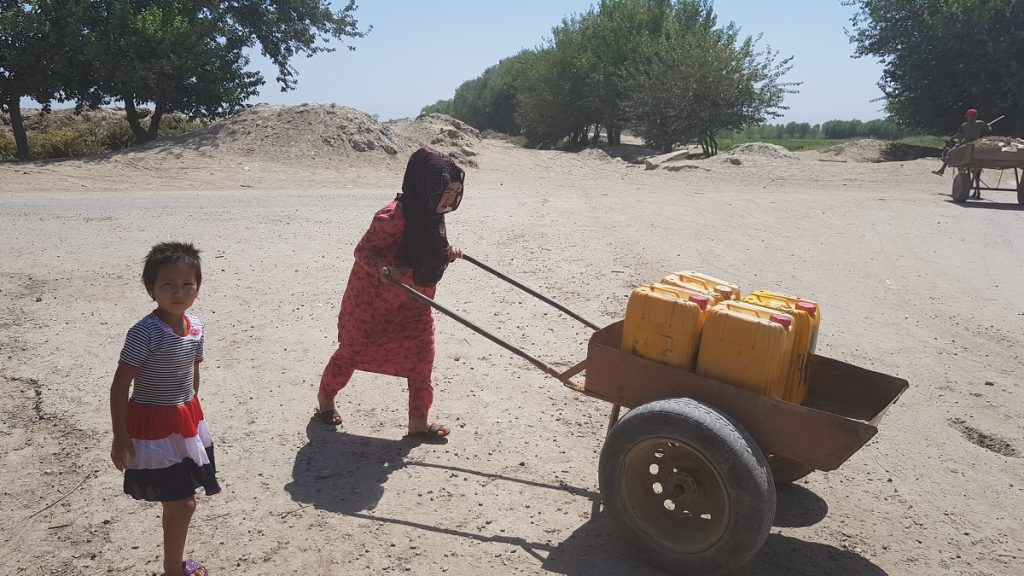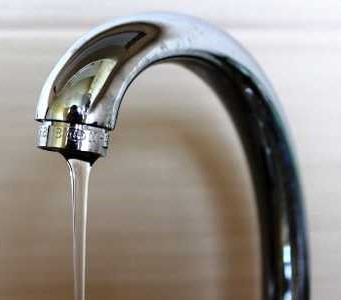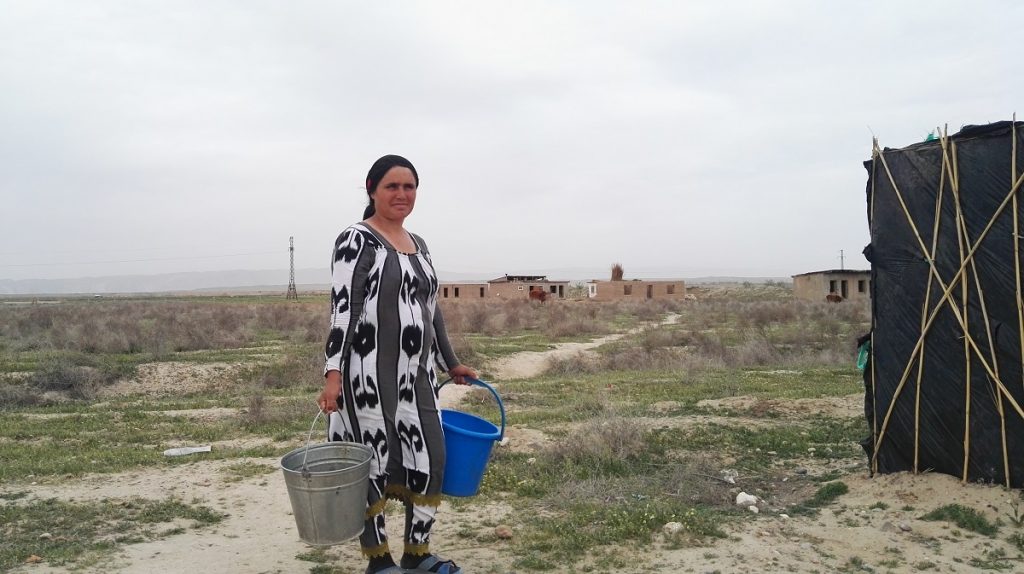Sixty percent of all the water resources in Central Asia forms in Tajikistan. However, the half of its population faces many problems related to the access to drinkable water. From the whole volume of natural stocks of water Tajikistan uses only 17-20%.
Follow us on LinkedIn

Four international forums were organized by Tajikistan’s initiative: International year of clean water (2003), International 10-year “Water for Life” action plan (2005-2015), International year for cooperation in the sphere of water resources (2013) and International 10-year program “Water for sustainable development” 2018-2028.
A vast number of normative legal acts, including 15 programs, action plans and strategies for provision of drinkable water for population were designed and implemented on different stages with some of them being in a process of actual realization. However, given all the efforts, provision of drinkable water for population remains among country’s most important issues.Why there is a problem with access to drinkable water in Tajikistan?
Sixty percent of all the water resources in Central Asia forms in Tajikistan. However, the half of its population faces many problems related to the access to drinkable water. From the whole volume of natural stocks of water Tajikistan uses only 17-20%.
Four international forums were organized by Tajikistan’s initiative: International year of clean water (2003), International 10-year “Water for Life” action plan (2005-2015), International year for cooperation in the sphere of water resources (2013) and International 10-year program “Water for sustainable development” 2018-2028.
A vast number of normative legal acts, including 15 programs, action plans and strategies for provision of drinkable water for population were designed and implemented on different stages with some of them being in a process of actual realization. However, given all the efforts, provision of drinkable water for population remains among country’s most important issues.
Only the half of population has an access to drinkable water.
For today only 51, 4% of Tajikistan’s population has an access to drinkable water and good sanitary conditions. This group includes 86,9% of country’s urban population, 61,5% of municipal residents and 43,4% of those who live in rural areas. The remaining 49,6% of Tajikistan’s citizens are in acute risk of not having an access to drinkable water or using sanitarily and hygienically unsafe water.
Only 68% of water infrastructure in urban Tajikistan is in working condition, 7% is in partial functionality and 25% has a nonoperational status. In Rural areas, 40% of water infrastructure is active, 44% is not fully functioning and 16% is in workless condition[i].
By car and by donkey
The situation with access to drinkable water in rural areas of Tajikistan is even more problematic. The number of rural population that are exposed to water shortage is two times bigger than in bigger cities.
In particular, regions of Jaihun, Kabodiyon, Nosiri Khusrav, Vose, Abdurakhmoni Jomi, Shahritus, Vakhsh of Khatlon oblast, Konibodom and Panjakent regions of Soghd Oblast are of the most concern. Population in these regions usually attempt to collect water from ground sources water, which is not necessarily safe. Such situation increases the risk of typhoid fever, diarrhea, cholera and bloody flux among those who use such sources of water.

A similar pattern can be observed in Regions of Republican Subordination and Gorno-Badakhshan Autonomous Region (GBAR). As Yodgor Faizov, head of GBAR, stated that even the half population of region center, Khorug, have problems with an access to drinkable water[ii].
Those who do not have a proper access to water fall back on other ways. Some people buy water from water tank that are brought by trucks to villages and towns lacking drinkable water. As a rule, a price for one water bearer may fluctuate between 80 and 150 somoni (8$-15$) depending on volumes and delivery distance.Others try to fill up their water stocks from distant wells and other water sources using carts moved by horses or donkeys to transport the collected water.
In cities, access to drinkable water is also far from perfect. For example, in Dushanbe the majority of multistory buildings water supply is cut off from 11 pm. In dormitories, water is provided only within 2-3 hours twice a day.
What are the factors impeding water supplies for the population?
In given conditions, we can underline several major factors directly or indirectly causing the problems in water supply.
- Rapid population growth. Demographic dynamics is one of the main factors influencing the water provision. In post-soviet area, Tajikistan has the highest rates of population growth of 2-3% per year[iii].
Natural population growth increases the demand for drinkable water. Potentially it can become a reason of more problems with water supply in future. If in 1991 provision of water accounted for 11963 cubic meters per capita, then in 2015 the same indicator decreased to 7711 cubic meters per capita.
Population growth and increased demand for water require urgent actions aimed at regulation of distribution of water supply, management of water resources, effective use of water, introduction of power-thrifty water technologies in production sector and other appropriate measures.
- Natural disasters and urbanization. Mudslides and flood frequently cause devastation of villages every year. It also brings down water infrastructure that leads to massive relocation of people and establishment of new towns and villages. Depending on volume of precipitation, annually from 40 to 230 occasions of bigger and smaller mudslides are registered in Tajikistan. The damage it causes to economy is estimated to be from hundreds of thousand to tens of million USD. Only in 2018, 169 cases of natural disasters were registered in Tajikistan, 23 of which were detrimental to population and economy[iv].
Emergence of new settlements makes it even more complicated, as installment of new infrastructural units and water supply require time during which the population will not be having the access to water.
- Ineffective use of water. Big amounts of wasted water, water supply routes and equipment

Millions of cubic meters of drinking water are lost every year. Photo: rinnipool.ru malfunction and inconsiderate use of water by households are the reasons of water shortages. The construction in many regions is obsolete which result in leakages in water supply systems.
According to “Program of water reform of Republic of Tajikistan for 2016-2025”, 60% of water in bigger cities is wasted, in smaller cities and towns – 20%. In other words, over 50% of the whole amount of drinkable water is misused.
The main bulk of water supply system was established in 1960-80s serving for about 30-50 years. Wearing out and inadequate use became the reasons of exhaustion of water supply system. This situation leads to reduction of water provision, scales up the risk of mixing of drinkable and sewage water inside of water supply system, which eventually brings along epidemic outbreaks.
Annual water loss reached millions of cubic meters, which costs 3-4 million somoni (300 000-400 000 USD). Deteriorating state of water infrastructure is the main reason of slow development of access to drinkable water for Tajikistan’s population.
- Lack of financial resources. Fiscal deficiency is the key reason of problems in the water supply sector. Tariffs for utilities and additional allocation of funds are insufficient for technical support and advancement of water supply system. Consequently, Tajikistan is trying to appeal to international donors and investors for support.
Generally, in Tajikistan implementation of water supply is being supported from four sources: State budget, local budgets, investors and private funds of different companies and organizations.
What steps were taken?
Currently, several program are being implemented in order to solve the existing problems with water supply: Program for improvement of access of Tajikistan’s population to drinkable water for 2008-2020, Program of development of water sector for 2010-2025, Program for reforming of water economy of republic of Tajikistan for 2016-2025.
With accordance to Program of development of water sector for 2010-2025[v], in 2025, 96,53% of population are expected to have access to drinkable water. Among other things, this program expects that 96% rural population and 98% of urban population will have access to drinkable water, making allowance for the demographic growth. Realization of given program is planned to receive over 3 million somoni (352 000 USD), 70% of which are foreign investments.
However, some of the forecasts are quite dubious. Program indicates that population of Tajikistan will be listed as having 10 million people. At the same time, in 2018 Tajikistan’s population already reached 9 million people. The last evaluations of experts projected the country’s population to be 10,65 million in 2020[vi] and 12 million in 2025, considering annual population growth rate of 3%.
Inaccurate medium-term prognosis of demographic growth can substantially affect the perspectives of enhancement of water provision. Alongside water supply, issues regarding infrastructure require thorough consideration as well. Reconstruction and modernization of irrigation and drainage systems are crucial for food security and social stability.

The high depreciation of the water supply system is the reason for the need to seek for funds in the amount of $ 1.5 billion for the repair and maintenance of irrigation and drainage systems[vii]. Currently, the country’s economic ability to achieve these goals is insufficient.
Therefore, in the current conditions, the implementation of the planned programs should move from a medium-term category to a long-term one.The analysis of state funding over the past years demonstrated that financing of water resources management, land reclamation and irrigation, and providing the population with drinking water in 2016-2025 from the state budget, taking into account the annual budgets of the respective ministries and departments, will require more than 200 million somoni (about 20 million USD)
In addition, for the specified period, financing of more than 1.6 billion somoni was provided for these purposes at the expense of development partners. With the financial support of the European Bank for Reconstruction and Development, the World Bank, and the Government of Switzerland, six projects are being implemented to ensure public access to drinking water[viii].
These projects are:
1) Reconstruction of the water supply system for cities of northern Tajikistan;
2) Water supply for central cities of Tajikistan;
3) Reconstruction of the water supply system for cities of southern Tajikistan, phase 2;
4) Reconstruction of the water supply system for cities of northern Tajikistan, phase 2;
5) Water supply for the city of Dushanbe, phase 2;
6) Improving the drinking water supply and sanitation of the city of Khujand, phase 3.
Thus far, most of the ongoing reform activities for water reform are mainly carried out by international organizations. The main development partners of Tajikistan are World Bank (WB), Asian Development Bank (ADB), Swiss Agency for Development and Cooperation (SDC), Japan International Cooperation Agency (JICA), United States Agency for International Development (USAID), European Bank for Reconstruction and Development (EBRD), European Union (EU), Development Coordinating Council (DCC), United Nations Development Program (UNDP), NGOs and others.
Engaging of organizations and NGOs to participate in solving water problems is not yet complete. The effectiveness and quality of the work carried out must be carefully monitored. Sometimes NGOs receive grants in order to solve the problem of access of local people to drinking water, but the work is done at the least cost, appropriating the remainder of funds. As a result, after 2-3 years, due to poor quality work and failure of water supply networks, the level of population’s access to drinking water is reduced.
In this regard, along with attracting state and foreign investments for the reconstruction of drinking water supply lines and ensuring public access to drinking water, favorable economic mechanisms should be developed and introduced to attract private investment. At the same time, based on specific analyzes of the prospects for access to drinking water, financing opportunities and population growth, it is important to develop new programs.

At the opening ceremony of the High-Level International Conference on the International Decade for Action “Water for Sustainable Development, 2018-2028,” President Emomali Rahmon said that the development of a new program for clean drinkable water for the period until 2030 is in progress[ix]. Now, no matter what goals the program will pursue, it is important that the previous program and strategy did not meet the expectations.
Thus, along with the aforementioned factors, there are a number of problems affecting the system of accessibility of drinkable water. First, it is the lack of comprehensive accounting for rational water use throughout the country; untimely payment for water use; inadequate service tariffs and low cost of services, low level of rivers and springs, etc.
What needs to be done?
Given the current situation, I would like to express several thoughts on measures to improve people’s access to drinking water, which can give a positive result.
- Development and implementation of effective measures for water accounting, elimination of causes of water shortages in the water supply system, installing water meters for each user; construction of water intake facilities in the countryside.
- Secondly, development and implementation of the State Support Program for the Development of the Water Sector, including the creation of favorable economic conditions for attracting investments and favorable conditions for associations wishing or seeking to create their own water supply systems.
- Raising public awareness and their responsibility regarding the use of water, disseminating requirements for compliance with hygiene rules, including through the television network.
- Restoration, reconstruction and expansion of centralized water supply systems of cities and regions on the project basis.
- Depending on the current situation and in accordance with market conditions, make changes and additions to the existing laws within the water industry including the Law of the Republic of Tajikistan “On Water User Associations” and the Law of the Republic of Tajikistan “On Drinking Water Supply”.
- Tackling problems associated with water that is used for industrial purposes. In Tajikistan, due to the lack of recycling technology, such water is not completely disposed of, but goes through partial cleaning, the other part is discharged into rivers, which poses a serious threat to public health.
Meanwhile, the purity and recycling of water in industry are beneficial, both from an environmental and an economic point of view. In developed countries, the purification and reuse of water saves millions of dollars in revenue annually. Such experience can be useful for the economy and industry of our republic.
Thus, based on our analysis of the situation in Tajikistan and the results of the implementation of plans and programs, we can conclude that access to drinking water in Tajikistan is very problematic and it is impossible to reach solution at current pace in a medium term (5-10years).
However, one does not have to be pessimistic. We have plenty of opportunities to solve this problem. The International Decade of Action for Sustainable Development is a vital prerequisite for overcoming the challenges in Tajikistan’s water sector.
This article was prepared as part of the Giving Voice, Driving Change – from the Borderland to the Steppes Project implemented with the financial support of the Foreign Ministry of Norway. The opinions expressed in the article do not reflect the position of the editorial or donor.
[i] Программе реформы водного сектора Республики Таджикистан на 2016 – 2025 годы. от 30 декабря 2015 года №791/
[ii] Ёдгор Файзов: В Хороге 50% населения не имеют доступа к питьевой воде. 13 июня 2019 г.
[iii] Население и социальные индикаторы стран СНГ и отдельных стран мира 2013-2016.М.2017. –С.11-16.
[iv] Обзор о чрезвычайных ситуациях и гражданской обороне в Республике Таджикистан за 2018 год. Душанбе, 2018.- 84 с.
[v] Программа развития водного сектора Таджикистaна на 2010-2025 годы. Проект заключительного отчета. Душанбе, декабрь, 2009
[vi] Скрытая опасность: чем быстрые темпы роста населения грозят Таджикистану. 06.04.2017.
[vii] Экспертные данные Камолидинова А.: включая стоимость создания бассейновых станций мелиоративных машин.
[viii] Маълумот оид ба лоиҳаҳои амалкунандаи давлатии сармоягузорй. (ба ҳолати 1.07.2018с.)
[ix] Выступление на церемонии открытия Международной конференции высокого уровня по Международному десятилетию действий «Вода для устойчивого развития, 2018-2028 годы». Душанбе. 20.06.2018.


